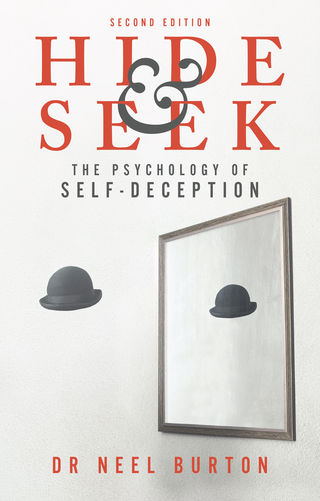Ethics and Morality
The Lucifer Effect: Creating Difference to Justify Atrocity
The uses and abuses of dehumanization.
Posted April 1, 2012
[Article updated on 7 September 2017]
The ego defence of dehumanization involves seeing other people as less or other than human so as not to have to think about them so much and/or feel guilty for neglecting or abusing them.
One simple example of dehumanization is that of a person who thinks of her partner or child as a pet or even a great teddy bear so as to better forgive his many failings.
Dehumanization is easier if the target person or people are marked out as being different, perhaps by age, gender, race, religion, social class, disability, sexual orientation, or even so little as a different style of dress. Thus, in everyday life, it is all too common to see people in uniform such as waiters, cleaners, bus drivers, and police officers being treated as mere automatons devoid of any such human attributes as feelings or families.
In April 2011, riots broke out in Bristol, England over the opening of a new supermarket. During the riots, one BC dropped a five stone concrete block from the top of a building onto an advancing line of police officers. The block caught officer NF square on the shoulder, knocking him flat to the ground. Instead of expressing anguish or remorse, BC continued rioting, and even exclaimed, ‘I want to find that copper I hit on the head. I want to do it again.’ During BC’s trial (he received a total sentence of 11-and-a-half years), the court heard that NF was recovering, but could not bring himself to tell his wife and three children about what BC had done to him for fear of upsetting them.
DD, a 62-year-old grandmother of nine from Anglesey in Wales, was holidaying in one of the most exclusive areas of Barbados. Then one day, in broad daylight, she was brutally raped by a complete stranger. One year on, in November 2011, she decided to talk about her ordeal in a national newspaper so as to expose the shabby treatment that she received from the island’s authorities. Of particular note is that she felt certain that she would have been killed had she not remembered reading that a victim of attempted rape should talk to the rapist so that he might see her as a person rather than as an object of gratification. ‘So I told him I was a 61-year-old grandmother with four children and nine grandchildren and felt he slightly softened. I think talking to him saved my life.’
Unfortunately, dehumanization is not limited to thugs and rapists, and may also be employed by supposedly decent, middle class people. For example, it is commonly employed by healthcare professionals to cope with distress at loss, grief, disease, and death – with patients being referred to by their diagnosis rather than by their name (‘the stroke in bed number 6’, ‘the fractured hip in the ER’…), or just being thought of in terms of a long line of faceless ‘patients’.
In the early 1970s, the psychologist Philip Zimbardo and his colleagues set up a mock prison with hidden cameras and microphones in the basement of Stanford University’s psychology building. The researchers selected 24 healthy, well adjusted undergraduate students, mostly white and middle class men, and randomly assigned them to the roles of either prisoner or guard. The ‘prisoners’ were to remain in the mock prison 24-hours a day, while the ‘guards’ were to ‘work’ in three-man teams over eight-hour shifts. The experiment – which, not surprisingly, has been heavily criticized for its ethics – had been due to run for 14 days, but had to be stopped after just six days due to the aggressive and abusive behaviour of the ‘guards’ and the extreme adverse psychological reactions of the ‘prisoners’, five of whom had had to be released early.
Even Zimbardo, who had been acting as the prison warden, had overlooked the dehumanizing behaviour of the guards until graduate student Christina Maslach voiced objections to him. In his subsequent book, The Lucifer Effect, Zimbardo candidly looks back over the experiment and says, ‘Only a few people were able to resist the situational temptations to yield to power and dominance while maintaining some semblance of morality and decency; obviously I was not among that noble class.’ The Stanford Prison Experiment attracted a lot of interest after the horrific abuses that took place in the Abu Ghraib prison in Iraq, and is often upheld to demonstrate the important effect that situation can have on human behaviour.
Dehumanization is particularly common during times of war, when it may be incited by governments in a bid to prosecute, or quell opposition to, the war. If people can be seen as less than human, then they become dispensable, and any atrocity can be justified. Thus, Josef Goebbels, the Minister of ‘Public Enlightenment and Propaganda’ (Volksaufklärung und Propaganda) in Hitler’s Nazi regime, ruthlessly employed all contemporary methods of propaganda to inflame already existing anti-Semitic feelings. By pinning the blame for all the economic and social ills of the time on the Jewish people and then lampooning them as an ‘inferior race’, Goebbels prepared the ground for the progressive elimination of their rights and freedoms and, one thing leading to the next, for the mass genocide of the Holocaust.
Neel Burton is author of The Meaning of Madness, The Art of Failure: The Anti Self-Help Guide, Hide and Seek: The Psychology of Self-Deception, and other books.
Find Neel Burton on Twitter and Facebook



